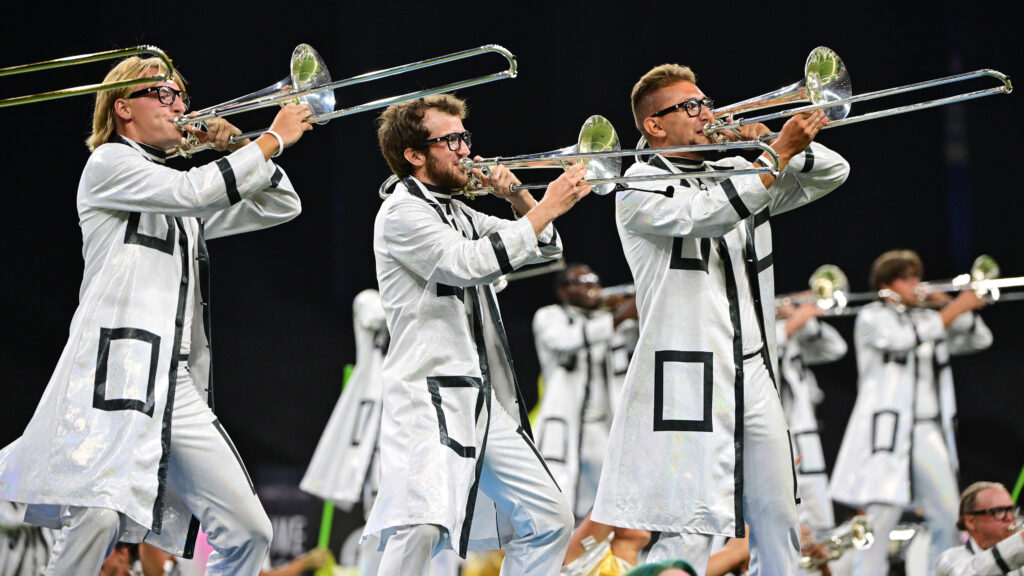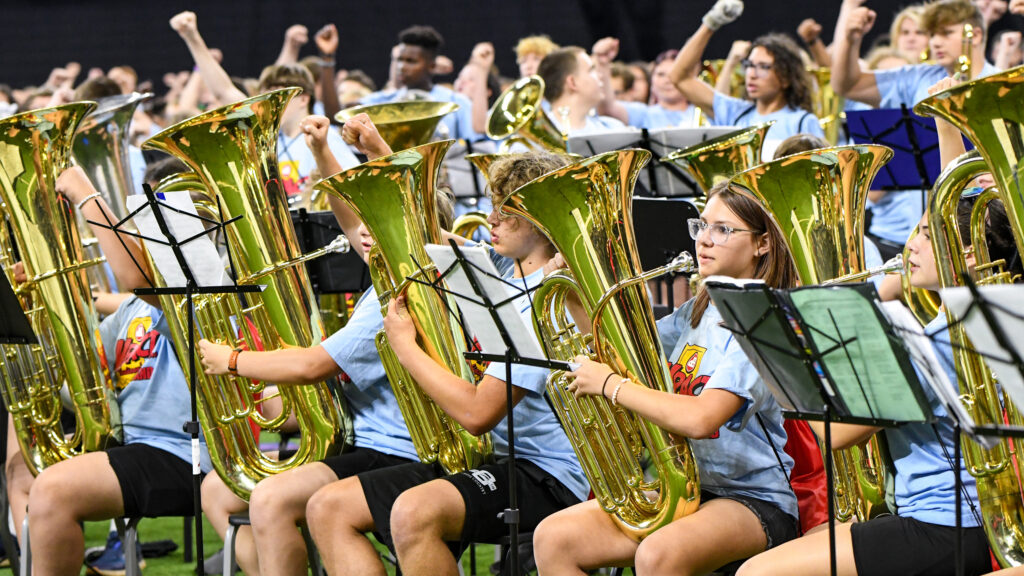In all of Drum Corps International’s years, there have only been three ties for the World Championship title, and all three ties occurred within five years, 1996-2000. The final tie came between the Cadets and the Cavaliers at the 2000 DCI World Championships, held at the University of Maryland’s Byrd Stadium. Despite that tie, there were a number of other reasons to remember this unique season in the evolution of DCI’s history.
The big news to fans prior to the 2000 season was that any-key brass instruments were now allowed by DCI rules. Despite that new opportunity, the Cadets and the third-place Blue Devils were the only corps that didn’t play the older G-keyed bugles. The reason for most corps was simple economics; already having G bugles still in good working order, most corps found it prudent to wait awhile before making the switch.
Another change in 2000 was that each corps’ color guard score was finally added to the adjudication recaps. Although a guard champion had long been declared during the Finals, prior to 2000, the guard contribution was just factored into the visual scores.
And in a change that would help preserve DCI memories for generations to come, the World Championships started to be preserved on the relatively new DVD format.
Glassmen finished 2000 in 8th place with a show dedicated entirely to George Gershwin’s 1925 “Concerto in F.” Earlier in the season, the corps had knocked off the 5th, 6th, and 7th place corps, and had placed 1st or 2nd in 17 of its first 18 contests. The concerto, originally written for piano and orchestra, was the 27-year-old’s first attempt to score his own music for orchestra. Coming a year after “Rhapsody in Blue,” which was orchestrated by Ferde Grofé, Gershwin bought “four or five books on musical structure to find out what the concerto form really was.” He studied the books on his way to London to open a new musical.
Gershwin was already firmly established as the most successful Broadway composer of the day. Despite his immense success, he strongly desired to show he was capable of much more than writing just for the theater. So, when the commission came through from New York conductor Walter Damrosch, Gershwin jumped on the opportunity to prove himself as a “serious” composer, and also to disprove critics who wondered if the success of “Rhapsody in Blue” had been a fluke.
Glassmen’s production started out with a bang from the drums and a quickly evolving series of drill formation squiggles in the horn line, leading into the first big hit of the main melody from near the concerto’s finale. How all the squiggles converged into a block parallelogram standstill in just eight counts is particularly pleasing to watch on the DVD.
Then, the “Allegro” first movement of the concerto took off. Gershwin described this movement as being “quick and pulsating, representing the young, enthusiastic spirit of American life.” That enthusiasm could be seen in the happiness displayed by the color guard members.

After saying all there was to say regarding the first movement, Glassmen moved into the second movement, “Adagio – Andante con moto” (in slow tempo – walking speed, with movement). Gershwin wrote the following: “The second movement has a poetic, nocturnal atmosphere which has come to be referred to as the American blues, but in a purer form than that in which they are usually treated.”
Flags of white curved forms upon a black background, the primary colors of the corps’ uniforms, underscored the “purer form” to which Gershwin referred.
A drum break interrupted the lovely blues, leading back to elements of the first movement as rifles and colorful jazzy flags of yellow, purple, and orange threw light upon the “nocturnal atmosphere.” A low and sustained tone in the contra/tuba section led into the next segment, the elegiac slow “Andante con moto” from the second part of the second movement. The “Andante con moto” is considered by many to be the soul of the concerto, and as such, perhaps even the soul of what Gershwin was trying to accomplish with his writing for “serious” venues.
A mellophone and soprano duet started off the segment with restrained elegant emotion, and then, just as in the original, the segment kept building in intensity to the point when it could no longer be held back, resolving its passion by ending with a gentle pas de deux for a male and female color guard member.
Gershwin had this to say about the third and final movement of the concerto, titled, “Allegro agitato” (fast and restless): “The final movement reverts to the style of the first. It is an orgy of rhythms, starting violently and keeping the same pace throughout.”
Bright yellow colored flags with blue crown-like forms added to the edginess of the music. This was the part of the show where nothing was held back, duplicating the full-throttle enthusiasm Gershwin wrote into the music. Emotions seemed to be laid bare for the ragtime-influenced first part of this segment, brought in check only so there would be someplace to go toward the end of the show.
Seen throughout the final segment of the show was a variety of pivoting block triangle drill formations, reflecting the corps’ logo on the front of the uniforms. Flags changed to a vibrant mass of pink and yellow, with four long triangular slashes of black that appeared as piano keys when spun.
For this week only, you can save on the 2000 DVD set that contains this complete Glassmen performance.
Buy the 2000 World Championship DVD set.
(Available 20% off for a limited time only.)
DVD offer ends Monday, June 6, 2016.





